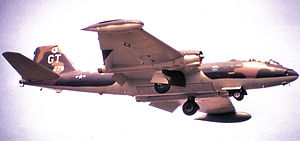| B-57 Canberra | |
|---|---|
 B-57E of 556th Reconnaissance Squadron in 1970. | |
| General information | |
| Type | Tactical bomber |
| Manufacturer | Martin |
| Status | Retired from military service; 3 in use by NASA[1] |
| Primary users | United States Air Force |
| Number built | 403 |
| History | |
| Introduction date | 1954 |
| First flight | 20 July 1953[2] |
| Retired | 1983 (USAF) 1985 (Pakistan) |
| Developed from | English Electric Canberra |
| Variants | Martin RB-57D Canberra |
| Developed into | Martin/General Dynamics RB-57F Canberra |
The Martin B-57 Canberra is an American-built, twin-engined tactical bomber and reconnaissance aircraft that entered service with the United States Air Force (USAF) in 1953. The B-57 is a license-built version of the British English Electric Canberra, manufactured by the Glenn L. Martin Company. Initial Martin-built models were virtually identical to their British-built twinjet counterparts; Martin later modified the design to incorporate larger quantities of US-sourced components and produced the aircraft in several variants.
The B-57 Canberra holds the distinction of being the first jet bomber in U.S. service to drop bombs during combat.[3] The Canberra was used extensively during the Vietnam War in a bombing capacity; specialized versions of the type were also produced and served as high-altitude aerial reconnaissance platforms (the Martin RB-57D Canberra), and as electronic warfare aircraft. The B-57 Canberra was also sold to export customers abroad; further combat use was seen by the Pakistani Air Force during the Indo-Pakistani War of 1965 and the Indo-Pakistani War of 1971.
In 1983, the USAF opted to retire the type; the B-57 Canberra's retirement marked the ending of the era of the tactical bomber. The three remaining flightworthy WB-57Fs are technically assigned to the NASA Johnson Space Center, next to Ellington Field in Houston, as high-altitude scientific research aircraft but have also been used for testing and electronic communications in the U.S. and Afghanistan.[1][4]